Numbers of bomb threats and false alarms following the deadly Feb.
14 shooting at the Marjory Stoneman Douglas High School in Parkland, Florida have jumped, causing fear and panic across the U.S. and creating havoc for school personnel and law enforcement.
The threats are mostly carried out by students too young to realize the repercussion of their comments—which most often are posted on social media sites.
The sharp rise in false alarms, from 10 to about 70 a day, has left school administrators and authorities with the precarious job of determining the threat’s credibility. Worried parents often fear sending their children to school.

Every school day in the week after Feb. 14, the day of the attack at the Florida high school, at least 50 threats or violent incidents at schools were reported across the country, according to the Educator’s School Safety Network, an advocacy organization that has tracked news reports of threats and violence since 2016. Normally, the group records an average of 10 to 12 incidents a day.
online pharmacy cellcept with best prices today in the USAThe group’s count includes many incidents that turn out to be false alarms or hoaxes.
Since the shooting, Texas has had the most threats, with 55 reports, followed by Ohio, California, Florida and Pennsylvania, according to data from the Educator’s School Safety Network, which tracks such incidents and also trains schools on how to handle them. Because of the threats, at least 33 schools closed and more than 15 others were locked down, according to the USA Today Network.

The threats have sparked a legal debate over what penalties kids should face. Authorities have yet to determine, however, how to deal with such threats, as an arrest could jeopardize a student’s future.
These types of threats are not new. Following the massacre at Columbine High School in 1999, hundreds of threats were sent to schools across the country, leading to more than 350 arrests. USA Today notes that even with jail as a penalty, threats have been widespread for decades and are not letting up.


 The TSA set up a passive system known as a stand-off explosive detection unit at the Amtrak concourse to identify individuals carrying/wearing a person-borne improvised explosive device (PBIED), such as a suicide bomb or vest. Such a vest was worn by terror suspect Akayed Ullah, when he attempted to blow himself up in a tunnel connected to the Port Authority in Midtown Manhattan last December.
The TSA set up a passive system known as a stand-off explosive detection unit at the Amtrak concourse to identify individuals carrying/wearing a person-borne improvised explosive device (PBIED), such as a suicide bomb or vest. Such a vest was worn by terror suspect Akayed Ullah, when he attempted to blow himself up in a tunnel connected to the Port Authority in Midtown Manhattan last December. Earlier this month, Amtrak President Richard Anderson told the
Earlier this month, Amtrak President Richard Anderson told the